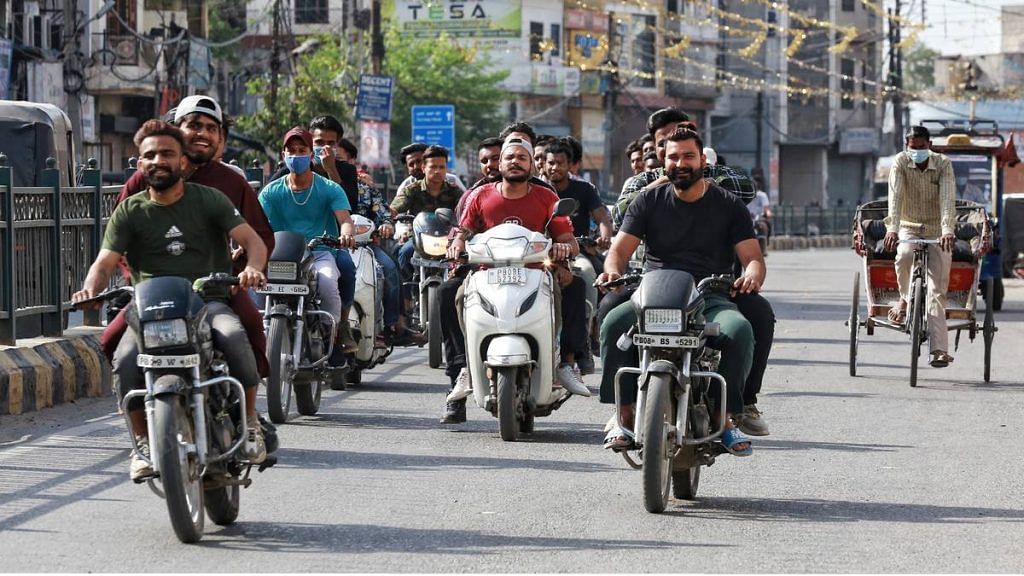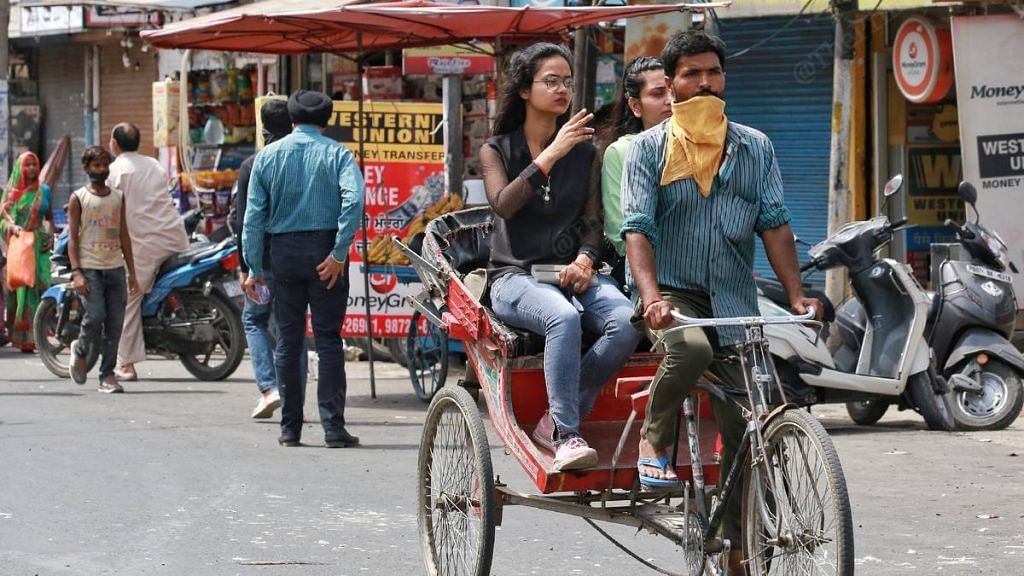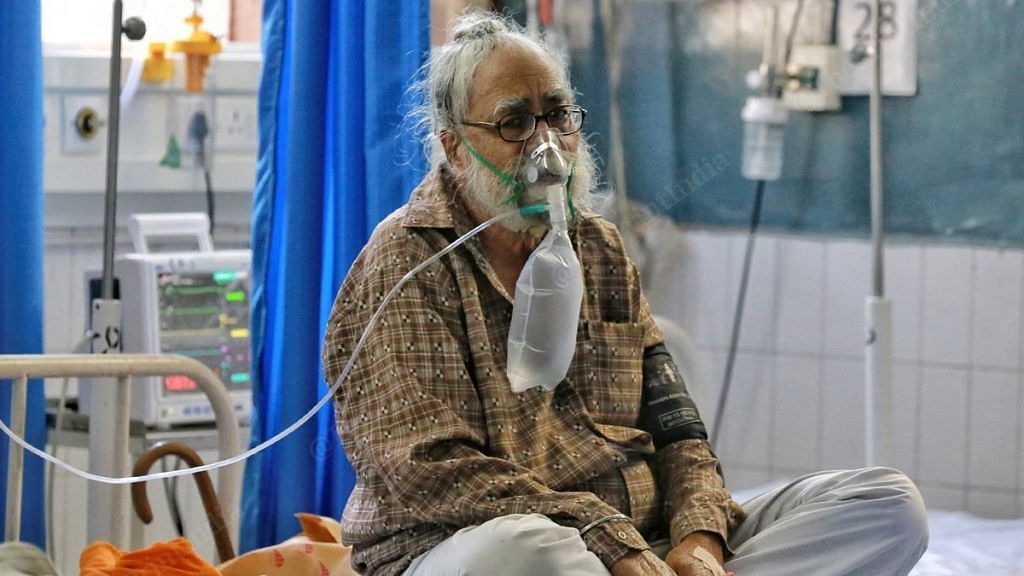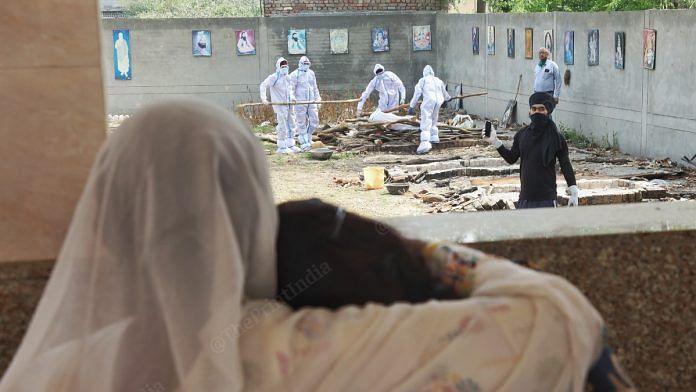Hoshiarpur/Jalandhar: It’s just a day before Holi, a lazy Sunday afternoon, and Hoshiarpur’s market is flooded with people without masks. Children run through the city’s narrow lanes with fistfuls of colour and water guns. Less than three kilometres away, a body is being brought in to the cremation ground — the only one in the city catering to those who succumb to Covid-19. Protocol dictates that very few are allowed to be present during the ceremony, while those lighting the pyre have to be covered in a PPE kit.
The 57-year-old man being cremated is one of eight coronavirus deaths reported from the district on that day, 28 March. Two days before, on 26 March, 14 deaths were reported in Hoshiarpur — the highest so far. And the trend has only continued, with nine deaths being reported on 31 March, taking the toll to 515.
It’s a similar tale in Jalandhar, nearly 50 kilometres away. Like Hoshiarpur, it too reported nine deaths on 31 March, and a record daily high of 14 on 26 March. The total number of deaths in the district now stands at 915.
Hoshiarpur and Jalandhar both lie in what is known as Punjab’s NRI belt, and seem to be ticking time bombs in terms of Covid infections. These two districts, along with the other two districts in the ‘Doaba’ region — Kapurthala and Shaheed Bhagat Singh Nagar —account for 26 per cent of Punjab’s Covid-19 cases and 27.68 per cent of the state’s deaths.
The total number of cases in these four districts is 60,475, out of Punjab’s figure of 2.32 lakh, while the figures for deaths are 1,907 and 6,868 respectively.
Authorities suspect this spurt is being caused by the deadly variant of Covid-19 found in the United Kingdom, which is reportedly 70 per cent more contagious.
The ‘NRI belt’, also known as Doaba — the region that lies between the Sutlej and Beas rivers — derives its name from a considerable segment of the Punjabi diaspora, now in Canada and the United Kingdom, that traces its roots back to the region.
“About 60-70 per cent of those living in Doaba have a relative abroad. They keep returning to their ancestral homes every year, which has proven to be a problem for us as the new UK variant spreads,” says a healthcare department official.
“We have over 80 per cent Covid-19 cases of the UK variant. People have brought this virus from outside the country,” adds Dr K.K. Talwar, adviser to the Punjab government on Covid-19.
There is no data, he says, to support the argument that farmers’ protests are responsible for the surge in this area, though “there is no doubt” that crowded places are prone to becoming super-spreaders.
Also read: Thousands gather for Hola Mohalla festival in Punjab, give masks & social distancing a miss
Why this wave is different
This wave of Covid-19 is different from the ones in the past. A growing number of younger people — those in their 40s, and some without comorbidities — are being infected severely and even dying.
“It is too early to quantify this with figures. But this wave has proven more dangerous to the younger population. Earlier, those in their 40s would be asymptomatic, but now they have to be hospitalised,” says Dr Ranjit Singh Ghotra, civil surgeon in Hoshiarpur.
Apneet Riyait, deputy commissioner of Hoshiarpur, echoes this, saying not only is the UK strain more prevalent in this region, but also that studies have shown it is affecting the younger population severely. “This wasn’t the case in the last waves where those above 60 were more vulnerable,” she says.
While those in their 40s and without comorbidities are succumbing to the virus, health department officials maintain that their number remains significantly lower than those above 60 and with comorbidities. A similar trend is being recorded in the national capital. AIIMS chief Randeep Guleria has said the new surge is infecting the younger population with “relatively milder symptoms”.

Travel to and from the UK was restricted briefly between 21 December 2020 and 8 January 2021. While scheduled flights remain suspended, 30 flights are being operated every week — 15 each by Indian and UK carriers — under the ‘air bubble’ arrangement.
Chief Minister Amarinder Singh underlined this on 23 March, sharing data that showed of the 401 representative samples collected from the districts between 1 January and 10 March, 81 per cent tested positive for the UK variant. Punjab’s case fatality rate (CFR) has increased by 80 per cent between January and March.
Analysing data, Murad Banaji, a mathematician at Middlesex University, London, argues that “Punjab’s case and fatality data is consistent with the greater deadliness of the variant which has taken hold in the state”.
The UK strain spreads quickly and explains the spurt in the number of Covid-19 cases in the state. Punjab Health Secretary Hussan Lal tells ThePrint that in January-February, Punjab’s positivity rate was 1 per cent. Now, it is 6.5-7 per cent.
According to the World Health Organization guidelines, positivity rate must remain below five per cent for 14 days before an area can be unlocked. As of now, 11 districts of Punjab — including all four in Doaba — have been put under night curfew.
‘People not willing to accept severity of pandemic’
Chants of ‘Hey Ram’ echo in Hoshiarpur’s city crematorium, as family members perform the last rites. “For the past three weeks, we have noticed a rise in Covid deaths. From Hoshiarpur city alone, three-four bodies come on a daily basis. A year ago, there were not so many deaths,” says Ashwani Sharma, member of Hoshiarpur’s Prabandhak Committee and manager of the cremation ground.
As of 31 March, the total number of cases in Hoshiarpur has risen to 14,566, while active cases stand at 1,693. It’s a sharp increase from the roughly 500 active cases in January, Dr Ghotra points out.
Sharing data on the 100 samples from Hoshiarpur that were sent for genome sequencing, Dr Ghotra says 39 results have been received, of which 36 tested positive for the UK strain. “This is a huge source of worry for us. People are just not ready to accept the severity of the pandemic,” he said.

While there is no concrete data yet to prove the prevalence of the UK strain in Jalandhar, authorities believe it to be the reason behind the sudden surge.
“There is no doubt that Jalandhar is one of the hubs of the NRI population. This time last year, Covid-19 cases began from the NRI belt under which Jalandhar falls,” says Dr Balwant Singh Rana, civil surgeon, Jalandhar.
Dr Parminder Kaur, senior medical officer of the district’s Civil Hospital, adds the UK strain is spreading quickly in Jalandhar, yet people are still delaying coming to the hospital. The new strain is much more dangerous than the last one, she says, with a greater number having become vulnerable.
Also read: Punjab blames comorbidities, ‘roster’ of protesting farmers for Covid surge, Centre disagrees
Late hospitalisation
Strengthening healthcare facilities is the only option in such an environment. Hoshiarpur has 175 secondary care beds in both government and private hospitals and just seven tertiary care beds, all in private hospitals. While the plan to increase secondary care beds is already in the pipeline, critically ill patients continue to be referred to Government Medical College, Amritsar.
Private hospitals have been roped in to buttress the tertiary care infrastructure. Secondary care facilities are also being strengthened so that patients don’t need to be shifted to a tertiary care bed. But reluctance to come to hospitals, and then to be shifted to Amritsar if the need arises, continues to be a problem with patients in Hoshiarpur.
“Home-isolated patients, especially those with comorbidities, are checked on daily. Among them, mortality is low. But with those who don’t come to the hospital on time, mortality is high. Of the roughly 2,000 active cases, just 115 are currently hospitalised. It is obvious that people aren’t getting admitted on time,” Dr Ghotra says, adding that the death rate among hospitalised patients is very high. But he did not specify a figure.

With 352 tertiary care beds and 968 secondary care beds, Jalandhar has a stronger healthcare system. Of the 284 secondary care beds in the district’s Civil Hospital, 55 are occupied, of which 46 patients are positive and nine are suspected to have Covid-19. Meanwhile, 35 of the 56 tertiary care beds are currently occupied. The hospital records two-three deaths on a daily basis. Most deaths reported are above the age of 60, while over 90 per cent of them have comorbidities such as diabetes and hypertension.
However, the practise of delayed hospitalisation is a problem here as well. “When patients are admitted, they straightaway go to the tertiary care facility,” says Dr Balwant Rana.
With an average population of 15,86,625 and an area of 3,386 square kilometres according to the 2011 census, a majority of people in Hoshiarpur — 78.89 per cent — live in rural areas. Due to this, the absolute number of coronavirus cases may be high in the villages, “but if you compare urban figures to rural ones, the ratio of both cases and deaths is higher in the former,” says Dr Ghotra.
“The virus has spread in rural areas this time, unlike last time. However, I believe the spread will rise for a few days, plateau and then decrease,” says Deputy Commissioner Riyait.
Similarly, in Jalandhar — that has a population of 21,93,590, of which 47.07 per cent is rural — cases have been on the rise in rural areas but a greater number of deaths has been reported from urban areas. The rural population is constantly moving from villages to the city because of work. They pick up the virus from the urban areas and spread it in the rural areas. Most of the time, those spreading it are asymptomatic cases.
Testing ramped up
Now, owing to the surge in cases, testing has been ramped up significantly in both Hoshiarpur and Jalandhar. From 1,200-1,500 tests per day in January, Hoshiarpur is now testing around 3,000 people daily, with a positivity rate of around 8-9 per cent.
“We have severely intensified vaccination as well — around 8,000-9,000 people are being inoculated daily. All healthcare and frontline workers have been vaccinated. We will do a targeted vaccination drive catering to bus drivers, shopkeepers and more,” Riyait says.
Jalandhar is testing around 5,000 samples daily, up from 3,500-4,000 in January. Currently, there are 104 centres for vaccination in Jalandhar district, with the number set to increase to 300 in the next two days. Till now, 80,000 people have been vaccinated.
Despite such efforts, healthcare authorities remain concerned about delayed hospitalisation and violation of safety protocols. “We are doing everything possible to ensure the deaths are under control. Doctors are working round the clock, but patients come to us in a very precarious condition,” Dr Kaur says.
Also read: Punjab reports over 1,000 new Covid cases in a day, pushes India’s daily tally to 16,838




THE MAJORITY OF THESE PEOPLE ARE GOING IN AND OUT OF HOUSES IN LARGE NUMBERS AND PLACES OF WORSHIP LOCAL SHOPS AND TOWN CENTRES SPREADING THE VIRUS. THE BORDERS SHOULD HAVE BEEN CLOSED LAST YEAR AND FREEDOM OF MOVEMENT STOPPED AND PEOPLE SHOULD HAVE BEEN FORCED TO WEAR MASKS WITH ON THE SPOT FINES THE JOHNSON GOVT HAS FAILED ON MANY FRONTS WITH WEAK LEADERSHIP.
One Needs TO Ask Which Groups Are The Cause Of The Covid Variant Spreading In Western Countrys Like England In The First Place And The Answer Is Illegal Immigrants/Bogus Students From States Like Punjab Not The Other Way Round. Most Of The Dead Are From Indian Moslim. African And West Indian Extraction Living In Ghettos Like Southall- Birmingham- Wolverhampton/Coventry Bradford And A Few Other Deprived Areas Followed By The Native Home Grown White Chavs And Pikeys Or Tappers As They Were Called In Our Day. These People Are Going Back And Forward To There Home Land Infesting Along The Way.